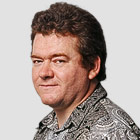Poor John Constable. What did he ever do except go out in the fields and paint? For that apparently harmless pursuit, it seems Tate Liverpool cannot forgive him. Its attempt to define a “radical” British landscape art keeps kicking Constable as a convenient shorthand for the “conservative” landscape tradition it rejects.
His painting Flatford Mill (Scene on a Navigable River) is shown near a looped clip from John Berger’s Ways of Seeing. If you can shut out this insulting reduction of Berger to an intrusive soundbite, you have to contend with a lengthy wall text that tells us Constable’s “idealised image of nature and rural life” creates an idyll “in contrast to the reality for workers of the time”.
Like a rambler from the city with no feel for the countryside, this exhibition strays into the brambles and thickets of intellectual confusion. For Constable’s painting, if you give it the chance the curators don’t, is a detailed view of a canalised stretch of river where a barge is getting a tow from a horse on the bank. The horse is ridden by a boy who turns to make sure the tow rope is secure. Or is he enviously eyeing another lad who is having a happy day fishing? For this is a portrayal of child labour. Far from ignoring the miseries of his age, Constable honestly depicts them.
Round the corner is Tacita Dean’s 2006 work Majesty, a tremendous black-and-white photograph of a gnarled old English tree isolated from its surroundings by layers of pale gouache. Other trees are visible as misty spectres through the whiteness but Dean has brushed over them to focus on this mighty old warrior with its winter branches like witch’s fingers. It is a modern masterpiece but what makes this “radical” and Constable “conservative”? There is just as much love of timeless, pastoral and, yes, unmistakably British nature in Dean’s woody reverie as in his depiction of barge life.
The exhibition could have been so much better, if it only accepted what Dean’s tree is silently saying – that love of landscape not only has radical and conservative sides but they coexist in the same work of art, the same experience of nature. By defining Constable’s and (if it followed its own logic) Dean’s love of the British countryside as something retrograde, oppressive and literally Tory, it makes nonsense of its own thesis that the land belongs to us all, as well as its warnings of the urgency of climate crisis. If loving green fields is wicked, why go there? If nature is exclusive, why save it?
The climate section is the most catastrophic. It feels as if the curators have selected works with a dull sense of routine to fill in blanks. Gustav Metzger’s Liquid Crystal Environment is a document of 1960s counterculture, which influenced psychedelic lightshows – but what has it got to do with landscape or climate? At least his other work here, a photo of massive roadworks framed within a rusty caterpillar track, does have a – slightly obvious – point. But why do so many contemporary climate artworks use state-of-the-art tech that actually embodies the energy guzzling consumer civilisation that’s the problem? Yuri Pattison uses a mind-boggling array of devices including an atomic clock to entirely shrug-inducing effect.
I suppose you could also accuse Jeremy Deller’s neon version of the Cerne Abbas giant of guzzling energy – but it’s a hilarious and liberating visionary delight. Deller has reproduced the famous chalk figure of a man with a huge willy waving a club in white neon against a green background. It’s more visually subtle than it sounds: the light brings the greenness to life and you get a real blast of the British landscape at its most romantic and mysterious. For a moment, the show starts to rock.
Deller’s obscene avatar of a primitive English past is surrounded by subversive encounters of ancient and modern. There’s a spooky film of Avebury stone circle by Derek Jarman, his camera homing in on the enigmatic stones like messengers in the dawn. Alan Lodge shows slides and videos of free festivals in the late 80s including at Stonehenge; the soundtrack had me wanting to shuffle along with these happy idiot savants in a field.
And that’s what this entire show could have been like: joyous, life-enhancing and therefore truly radical. It could have juxtaposed William Blake’s depictions of the ancient bardic British land with Deller and brought in masses of weird old folk art to show us the hidden popular story of the land. But no. Even when acid house is pumping out, this exhibition can barely let its hair down before exploring some other reason to be cheerless. Blake is represented only by a sneering text that disdainfully refers to this “green and pleasant land”. You’ll never build Jerusalem in a place you hate.
• Radical Landscapes is at Tate Liverpool until 4 September.











